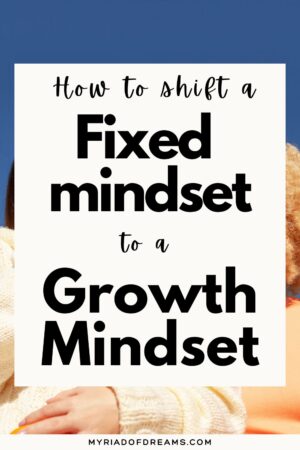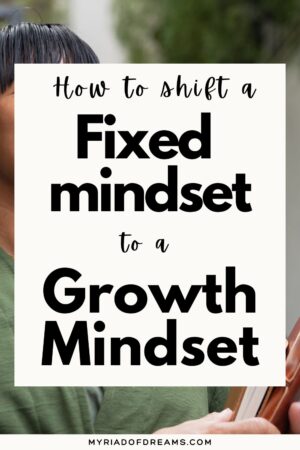
Let’s discover how shifting from a fixed mindset to a growth mindset can transform the way you approach challenges, helping you turn obstacles into stepping stones for success.
Have you ever wondered why some people seem to thrive in the face of challenges while others shy away, convinced they’ve hit their limits? The answer lies not in talent or intelligence but in something far more subtle—our mindset.
A mindset is the lens through which we see the world, shaping how we approach problems, learn new skills, and handle failure. It’s the difference between thinking, “I’m just not good at this,” and asking, “How can I get better?”
Psychologist Carol Dweck, who pioneered this concept, identified two primary mindsets: the fixed mindset, which believes abilities are innate and unchangeable, and the growth mindset, which sees potential as something we cultivate through effort and persistence.

The Foundation of Our Beliefs
First, let’s start with this: where do our ideas about abilities even come from? Have you ever thought about that? Growing up, many of us heard things like, “Oh, she’s so naturally smart,” or “He’s just not a math person.” These comments might seem innocent, but they plant powerful seeds. Over time, we internalize them and begin to believe that our abilities are fixed—like some sort of birthright or predetermined package.
Imagine a child who’s praised only for being “smart” when they ace a test. What happens the first time they fail? That praise can suddenly feel conditional, tied to their success. Instead of thinking, “I didn’t study enough this time,” they might think, “I’m not smart after all.” That’s the beginning of a fixed mindset: when failure becomes proof of limits, instead of an opportunity to grow.
The Fixed Mindset Trap
The fixed mindset is like living in a glass box. You can see possibilities outside, but the boundaries feel rigid. It tells you things like:
- “You’re either good at something, or you’re not.”
- “If you fail, people will judge you.”
- “Effort is for people who aren’t naturally talented.”
Think about a woman at work who’s always admired her colleagues who seem to excel in negotiations. A fixed mindset might make her think, “I’m just not a naturally assertive person, so I’ll never be good at negotiating.”Because of this belief, she avoids situations where she’d have to negotiate, whether it’s for a project deadline, a budget, or even her own salary. Why? Because attempting it and failing might confirm her fear that she simply doesn’t have the skill. It feels safer to stick to tasks where she’s already confident than to risk stepping out and challenging that belief.
But here’s the kicker: the fixed mindset isn’t just about fear of failure; it’s about fear of effort itself. If you believe talent is natural, then needing effort can feel like an admission of weakness.
A Growth Mindset Feels Like Freedom
A growth mindset is liberating because it says, “Abilities are not static. They’re like muscles—you can strengthen them with the right exercises.”
Take a woman who has always admired her coworkers’ ability to give confident presentations at work. Someone with a growth mindset might say, “I may not be great at public speaking right now, but if I practice and prepare for each presentation, I’ll improve over time.” She doesn’t expect to be perfect right away. Instead, she focuses on learning—rehearsing in front of friends, seeking feedback, and watching videos on speaking techniques. Each attempt becomes less about instant success and more about enjoying the process of building a skill that will serve her in the long run.
What’s fascinating is that science backs this up. Our brains are plastic. That means they can grow and change, even in adulthood. Each time you try something new, you’re literally building new neural pathways. So when you practice, your brain starts rewiring itself, saying, “Ah, so this is how it’s done!” That’s the beauty of a growth mindset: it aligns with how we’re designed to learn.
Failure: The Best Teacher
One of the hardest parts of developing a growth mindset is rethinking failure. Let’s be honest—failure sucks. It stings. It makes you question yourself. But here’s the difference: in a fixed mindset, failure feels like a dead end. In a growth mindset, failure is feedback. It’s part of the process.
Think about Thomas Edison and the light bulb. You’ve probably heard his famous quote: “I haven’t failed. I’ve just found 10,000 ways that won’t work.” That’s growth mindset in action. For Edison, each “failure” was simply a stepping stone to success.
Can you imagine if he’d stopped after the first attempt and thought, “Well, I guess I’m not a natural inventor”? The world would be a darker place—literally.
Challenges and Their Role
Now let’s talk about challenges. They’re uncomfortable, right? Think about the last time you had to do something totally out of your comfort zone. Maybe you had to give a presentation, learn a new skill, or start a project you weren’t sure you could handle. For someone with a fixed mindset, challenges feel like proof that they’re not good enough. They’ll avoid them at all costs.
But someone with a growth mindset? They lean into the discomfort. Why? Because they see challenges as puzzles to solve, not threats to their identity. It’s not that they don’t feel fear or doubt—they absolutely do—but they’ve reframed those feelings as part of growth.
Here’s an analogy I love: imagine a toddler learning to walk. Do they give up the first time they fall? No. They get up, wobble a bit, and keep trying. That’s growth mindset in its purest form. Somewhere along the way, though, we lose that natural resilience. We start to fear falling instead of seeing it as a step toward learning.
You may also like:
How to stop being lazy and become insanely productive
How to stop caring about what others think ; 8 simple ways
How To Let Go Of That Particular Incident
How Do You Shift?
Shifting your mindset—especially from a fixed to a growth mindset—takes time and intentional effort. But it’s absolutely doable, and the best part? It can transform how you approach challenges, failures, and opportunities. Here are some practical, actionable steps to help you make the shift:
-
Start Noticing Your Inner Dialogue
Pay attention to the thoughts you have when facing something difficult. Do you hear yourself saying, “I can’t do this” or “I’m just not good at this”?
Pause and challenge those thoughts. Replace them with growth-oriented alternatives like, “I may not be good at this, but I can learn.” Even writing these thoughts down can help you become more aware of patterns.
-
Embrace the Power of “Yet”
One of the simplest yet most powerful tools is adding “yet” to your thoughts. Instead of saying, “I don’t know how to code,” say, “I don’t know how to code YET.” This tiny word reminds you that your current state isn’t permanent and leaves the door open for growth.
-
Reframe Failures as Learning Opportunities
Every time something doesn’t go as planned, ask yourself, “What can I learn from this?” For example:
- Didn’t do well in a work presentation? Reflect on what could improve: Was it preparation, delivery, or nerves?
- Made a mistake at work? Instead of feeling defeated, think about how you can use this experience to avoid similar errors in the future.
Keep a journal where you write about lessons learned from setbacks. Over time, you’ll start seeing failures as stepping stones rather than roadblocks.
-
Celebrate Effort Over Results
Make a habit of acknowledging and celebrating effort rather than focusing solely on outcomes. For instance:
- Instead of saying, “I didn’t get the job, so I failed,” celebrate the fact that you put in the effort to apply, interview, and step out of your comfort zone.
- Reward yourself for sticking with something challenging, whether or not it leads to immediate success.
This builds a mindset that values persistence and process.
-
Surround Yourself with Growth-Oriented People
Surrounding yourself with growth-oriented people is a powerful way to nurture your own mindset. These individuals inspire you through their attitudes and actions, reframing challenges as opportunities and setbacks as lessons.
Watching how they handle adversity can shift your perspective, helping you see failure as a stepping stone rather than an endpoint.
By sharing your goals with them, you create a network of accountability—they encourage your progress, provide constructive feedback, and cheer you on through discomfort.
If such people aren’t already in your circle, seek them out through professional groups, communities, or even online spaces.
Over time, their mindset becomes contagious, influencing how you approach learning and growth, while your own transformation begins to inspire others.
-
Use Visualization Techniques
Visualize yourself succeeding in a clear, detailed way rather than as a vague dream like “I’ll be rich someday.”
For example, if you’re learning a new skill, imagine yourself practicing every day, working through small challenges, and steadily improving until you master it.
If you’re pursuing a big goal, picture the entire process step by step—the effort you’ll put in, the mistakes you’ll make, the lessons you’ll learn, and the ultimate moment when you achieve it.
This kind of visualization trains your brain to embrace the journey, not just the destination, helping you stay motivated and focused along the way.
-
Break Goals into Manageable Steps
Tackling significant goals can often feel daunting, but breaking them into manageable steps makes the process more achievable and less overwhelming.
For instance, if you aspire to master a new skill, begin with just 10 minutes of focused practice each day. If professional growth is your aim, commit to something tangible yet specific, such as reading one impactful career development book or enrolling in a targeted course.
Consistent progress, even in small steps, adds up over time and can lead to significant changes. By focusing on simple, intentional actions, you can build momentum and create steady, lasting growth.
-
Practice Gratitude for Growth
Taking time at the end of each day to reflect on what you’ve learned or how you’ve improved is a powerful way to foster growth and positivity.
This practice helps you recognize progress, no matter how small, and keeps you motivated for the journey ahead.
Perhaps you tried something new that pushed you out of your comfort zone, asked for help when you needed guidance, or persevered through a challenge instead of giving up.
These moments, however minor they may seem, are evidence of your resilience and willingness to grow. By focusing on these wins, you shift your mindset from dwelling on what’s missing or what went wrong to appreciating how far you’ve come.
This gratitude for progress, rather than perfection, creates a positive feedback loop that fuels your determination to keep learning and improving every day..

A Closing Thought
The difference between a fixed and growth mindset isn’t about who you are—it’s about how you think. And thinking can change. It’s not easy, but it’s worth it. Imagine the freedom of stepping out of that glass box and realizing the only limits are the ones you set for yourself.
